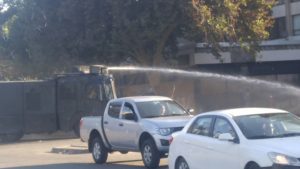Been Traveling
Been traveling. South America is pretty much a mystery to me. We’ve traveled very little here, don’t speak Spanish, and are woefully ignorant about its land or its people. Although we have been to Machu Picchu and the surrounding Sacred Valley—all amazing, but another story—that’s just a tiny slice of our southern neighbors’ continent.
Peter and I spent New Year’s Eve 2019 on a Delta flight to Santiago, Chile where we spent four days on the way to Ushuaia to then jump off the continent to South Georgia Island and the Antarctic Peninsula. We stayed in a nice hotel in the old part of Santiago, across a leafy green park from the trickle of the slow, brown Mapocho river; also, we discovered, the center of the violent street protests that began in October are still ongoing. We watched young men gathering each evening around 7 pm in our neighborhood. Some wore bandannas over their faces, a few carried flags or signs, some rode scooters. All were there to face squads of Kevlar, gun and riot-outfitted soldiers and police, whose vehicles were ominous-looking khaki-painted, windowless vans, pock-marked from thrown rocks. Some were tank-like water cannons on wheels.

Water cannon on streets of Santiago
Each evening, both groups gathered at intersections and squares, attacking each other’s forward margins with the weapons they had at hand—shouts and rocks from the demonstrators, against the water cannons spraying high pressure water on groups of demonstrators and anyone else standing around. Also, if that didn’t work, tear gas.
This area of Santiago is graced with lovely old stone buildings, with curved carvings and elegant facades. Since spray painted slogans are one of the demonstrators’ methods of making their demands visible, these buildings and statues are now sadly defaced—I’m not sure they can ever be completely cleaned. On the other side, the broken promises and crumbling economy led by the current Chilean government is also not a pretty sight, and a good deal more damaging to human life than a graffiti’d building.

Graffiti on Santiago’s buildings
So far there have been 29 deaths and thousands of injuries since these protests began last fall. The initial spark was an increase in Santiago bus fares, which has blossomed into widespread anger over income inequality, government corruption, and rising costs of basic living expenses. The current president is named Pinera, and much of the graffiti notes his name’s similarity to Chile’s military dictator Pinochet, who overthrew (with the help of the United States CIA) the country’s elected president Allende in 1973.
Next stop: South Georgia Island and the Antarctic Peninsula.